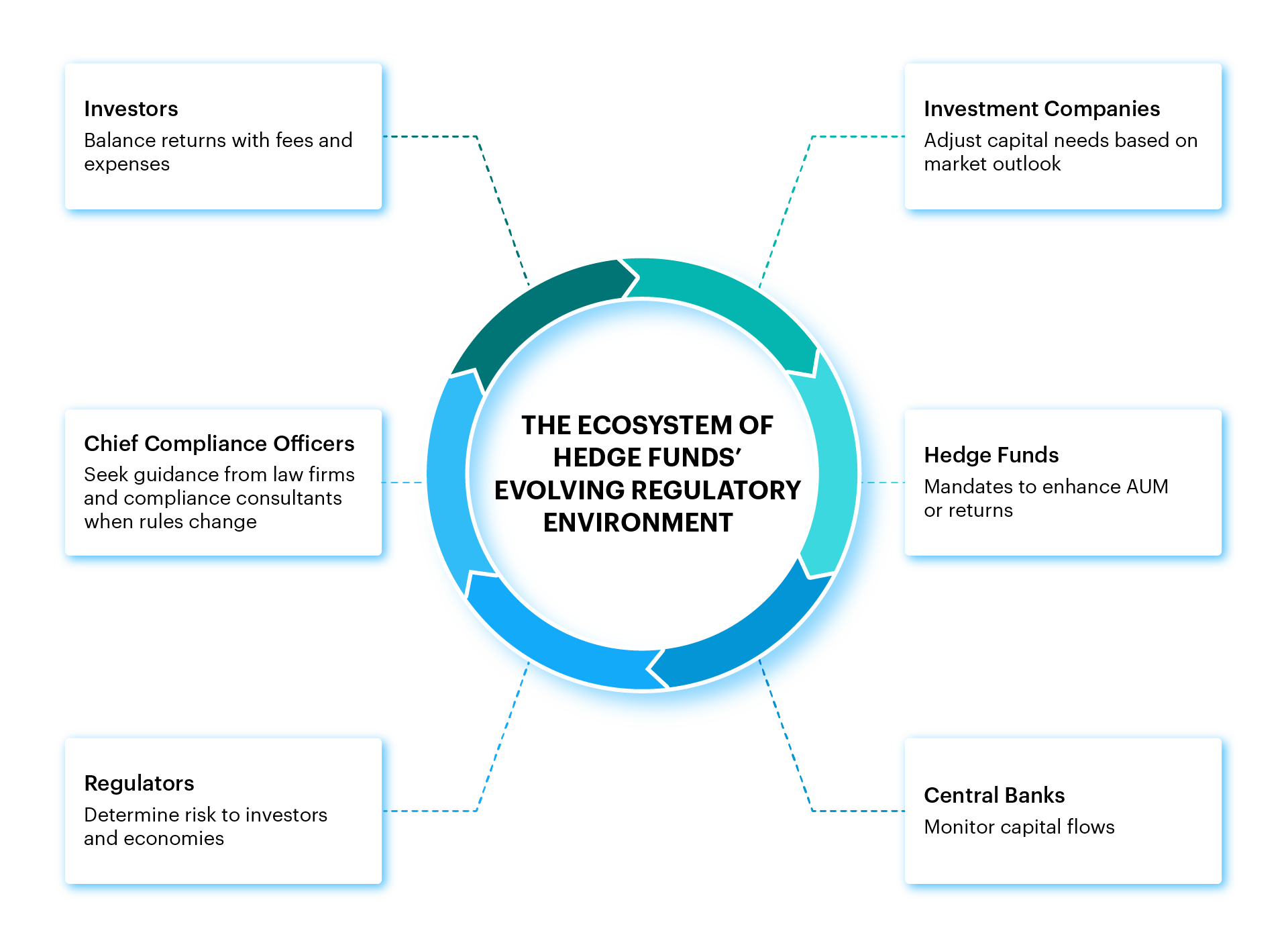The data governance essentials in an evolving regulatory environment
The value of assets that hedge fund manage reached new heights in 2023 at a staggering $5 trillion.[1] So too have industry complexities. As the importance of a strong data strategy increasingly takes priority for asset managers and hedge funds, the need for better data governance is rising to the top of the agenda.
Improving transparency is at the heart of data governance. By implementing purpose-built solutions, asset managers and hedge funds can effectively manage regulatory changes, adapt to shifting priorities, and ensure open lines of communication. These purpose-built solutions play a vital role in strengthening market positions and enabling hedge funds to navigate the evolving landscape of the financial industry.
In an interconnected world, data governance has become a strategic imperative. By prioritizing transparency and leveraging purpose-built solutions, institutions can effectively manage their vast portfolios, mitigate risks, and drive sustainable growth.
The demand for greater transparency
Hedge funds have seen demands for greater transparency from an ecosystem of regulators, investors, broker dealers, law firms, central banks, and the investment itself. Each entity has its own individual agenda, yet they all share a common dependence on the larger financial system.
- Investment companies
At the forefront of the financial industry, investment companies adjust their capital needs based on market conditions and outlooks to effectively manage their portfolios and optimize their investment strategies. - Investors
To evaluate returns along with the fees and expenses they’re charged, investors demand transparency to make informed decisions about where to allocate their capital. They want to understand the risks and potential returns associated with investing in a particular hedge fund. Detailed information enables investors to evaluate a fund’s track record, assess its investment approach, and determine if it aligns with their own investment goals. - Central banks and regulators
As the guardians of monetary stability, central banks monitor asset managers’ and hedge funds’ capital flows. By monitoring institutions’ activities and risks, central banks can proactively understand the potential impact on the wider economy, respond to potential warnings of financial stability, and adjust monetary policies. - Regulators
To determine risk to investors and economies, regulators seek greater transparency to ensure the stability and integrity of the financial markets. They require hedge funds to disclose key information such as their investment strategies, risk management practices, and performance metrics. By doing so, regulators aim to protect investors and maintain the overall health of the financial system. - Hedge funds
With mandates to raise further AUM or improve returns, hedge funds themselves benefit from greater transparency. By providing clear and detailed information to their stakeholders, hedge funds can build trust and credibility with their investors. This, in turn, can enhance their reputation, attract more capital, and ultimately contribute to their long-term success. - Chief Compliance Officers (CCO)
When rules change, a fund’s CCO will seek guidance from law firms and compliance consultants. With access to comprehensive and accurate information, a CCO can better evaluate risks and ensure compliance with regulatory requirements.

In recent years, stricter reporting requirements have put hedge funds on alert for greater transparency. Consider the daily requests of Form PF, amended AIFMD legislation, or the regulation of private fund advisors, just to name a few. That’s why each entity in the ecosystem plays a valuable role in maintaining a healthy financial system. As the industry continues to evolve, hedge funds must be ready to work collaboratively with regulators, investors, broker dealers, law firms, central banks, and the investment itself to meet transparency demands.
RELEVANT BLOG POST: IS YOUR FIRM REGULATION-READY?
Data governance and the intersection of competing agendas
Regulatory technology sits at the intersection of the various agendas. Hedge funds focus on the minutiae of a trade — what an engineer might call floats, strings, and timestamps — whereas regulators focus on crafting the policies, regulations, and legal actions that overlay a fund’s investment choices.
Technology is undoubtedly part of the solution to manage compliance expectations. For me, the fast turnaround timelines to settle trades and other demands of T+1 settlements immediately come to mind. Establishing a robust data governance structure is the X factor that will enable firms to create that robust technology to meet regulatory obligations.
The importance of data management
By implementing a strong data management solution, funds enhance how they collect, aggregate, and normalize information, while also incorporating risk analytics and preparing data in a format they can easily submit to regulators. This streamlined approach, supported by the right tools and reliable sources of information, empowers compliance teams to better comprehend and efficiently meet their regulatory and reporting obligations.
Data must relate to similar data to be enriched and ultimately produce artifacts for external parties, including investors and regulators. Data must be permanent for accountability and traceability and malleable so that firms can share it with relevant parties.
To meet new and evolving regulatory standards, firms should consider how they manage and access data on several key components:
- Data ownership
The legal right and control individuals or organizations have over the data they generate or collect. Data ownership encompasses the responsibility and accountability for the data throughout its lifecycle. - Data stewardship
Management and oversight of data assets to ensure integrity, accuracy, and security. Effective data stewardship ensures that data is properly classified, documented, trusted, and accessible to authorized individuals while safeguarding it from unauthorized access or misuse. - Defined policies
Clear guidelines and procedures that outline the rules and regulations governing the acquisition, storage, sharing, and disposal of data. Well-defined policies enable organizations to maintain consistency, transparency, and compliance in their data management practices. - Data quality management
Processes and techniques to ensure data meets accuracy, completeness, consistency, and relevancy standards. It involves data profiling, data cleansing, data validation, and data monitoring to identify and rectify errors or inconsistencies. - Regulatory compliance
Adherence to laws, regulations, and industry standards that govern data privacy, security, and usage relevant to its business processes.
The underlying technology must be dynamic to support the full needs of the ecosystem. By maintaining high data quality with defined policies that adhere to compliance obligations, organizations can make informed decisions, improve operational efficiency, and enhance customer satisfaction.
How RegTech helps firms plan for regulatory change
Data taxonomy with common language serves as the building blocks to help solve for the unknown. To effectively solve for the unknown, firms must have a strong understanding of their underlying data sources, variability, and methods for organizing and utilization.
Let’s take a security as an example. First, we must agree on what a security is and how it varies. Once we understand how the security moves based on various numerical attributes, such as prices, coupons, and fees, it allows us to tally, compile, and sort that security to wind and unwind based on how we want to analyze the security. The attributes for a given security can then serve as identification and allow systems to relate the security to any number of other attributes.
We refer to this concept as domain awareness. Unified systems capturing trades, transactions, positions, aggregations, accounts to counterparties, brokers, and more enable you to understand your firm’s data taxonomy. In this context, gathering, ingesting, and harmonizing data is the priority. Technology is just how you get there.
An inventory of domain-specific datasets, ready to mix and match, offers a broader set of use cases for data – whether for analytics, to enhance team collaboration, or to collect and report data to regulators. As your firm masters its data taxonomy, solving for challenges, such as regulatory reporting, becomes forward thinking and less reactionary.
When you have the right building blocks, data that aligns with compliance needs also supports a more strategic relationship between the front, middle, and back offices, and enables your firm to deliver comprehensive front-to-back information with external parties.
RELATED READING: DEMYSTIFYING THE PATH TO A MODERN DATA PLATFORM
What does a good data governance platform look like?
A good data governance platform enables you to aggregate, document, error check, and report on your data. And equally important, it lets you repeat those steps when jurisdictions or securities change. With the right data components, your business is in a stronger position to think strategically and use data as a true differentiator.
Data governance is as much art as it is engineering. It reflects the reality of how governance will always be changing to support the evolving ecosystem of hedge funds and asset managers.
Want to learn more about how to navigate your compliance obligations? Watch our on-demand webinar: Navigating the Evolving Regulatory Landscape with Data Governance Solutions.
Author:
Neil Visnapuu
Neil is Vice President of Product Management at Arcesium. He describes his role as focused on product with a splash of engineering. Neil has spent more than two decades in FinTech building compliance strategies and solutions for the financial services industry. Follow him on LinkedIn.
Sources:
[1] Value of assets managed by hedge funds worldwide, Statista, September 14, 2023
DISCLAIMER:
This blog post is made available for personal informational purposes only. It does not constitute legal, tax, or investment advice and should not be treated as such. Nothing on our blog constitutes an offer to contract or acceptance of contract terms you may offer to us. We contract solely by definitive written agreement reviewed and approved by counsel. Any views or opinions represented in this blog belong solely to the author(s) and do not represent those of Arcesium LLC, its affiliates, or any other individuals, institutions, or organizations associated therewith. Arcesium LLC and its affiliates do not represent, warrant, or guarantee the availability, accuracy, or completeness of the information contained in this blog and shall not be liable for any losses, injuries, or damages resulting from the display or use of such information.





 Back to Insights
Back to Insights Back to Insights
Back to Insights